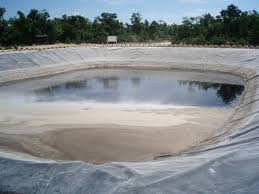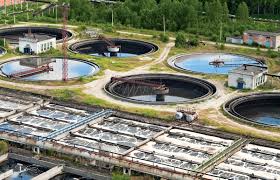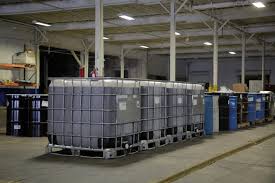Basic Requirements and Components of Sanitary Landfill
Sanitary landfill also known as controlled tipping is the practice of waste disposal in which waste is stacked to decay under controlled conditions. Wikipedia Encyclopedia defines it as a site for the disposal of waste materials by burial.
Historically, landfills have been the most common methods of organized waste disposal and remain so in many places around the world. Some landfills are also used for waste management purposes, such as the temporary storage, consolidation and transfer, or processing of waste material (sorting, treatment, or recycling).
Basic Requirements of Sanitary Landfill
As a minimum, four basic conditions should be met by any site design and operation before it can be regarded as a sanitary landfill:
Full or partial hydro geological isolation: if a site cannot be located on land which naturally contains leachate security, additional lining materials should be brought to the site to reduce leakage from the base of the site (leachate and help reduce contamination of groundwater and surrounding soil.
If a liner – soil or synthetic – is provided without a system of leachate collection all leachate will eventually reach the surrounding environment. Leachate collection and treatment must be stressed as a basic requirement.
Formal engineering preparations: designs should be developed from local geological and hydro geological investigations. A waste disposal plan and a final restoration plan should also be developed.
Permanent Control: trained staff should be based at the landfill to supervise site preparation and construction, the depositing of waste and the regular operation and maintenance.
Planned waste emplacement and covering: waste should be spread in layers and compacted. A small working area which is covered daily helps make the waste less accessible to pests and vermin.
Components of a Landfill
The main components of any secured, permitted landfill are:
Bottom Liner: – The bottom liner separates and prevents the buried waste from coming in contact with underlying natural soils and groundwater. In municipal solid waste landfills, the bottom liners are generally constructed using some type of durable, puncture-resistant synthetic plastic HDPE (high density polyethylene) ranging from 30 to 100 mils thick. The plastic liners may also be designed with a combination of compacted clay soils, along with synthetic plastic.

Cells(oldandnew):- This is the area in a landfill that has been constructed and approve for disposal of waste. These cells range in size (depending upon total tons of waste received each day at the landfill) from a few acres to as large as 20+ acres. Inside these larger cells are smaller cells known as the daily workface, or sometimes referred to as cells.
This is where the waste coming into the landfill for disposal that day is prepared by placing the material in layers or lifts where the waste is then compacted and shredded by heavy landfill compaction machinery.
Leachate collection system: – The bottom of each landfill is typically designed so that the bottom surface of the landfill is sloped to a low point, called a sump. This is where any liquids that are trapped inside the landfill known in the waste industry as leach ate are collected and removed from the landfill.
The leach ate collection system typically consists of a series of perforated pipes, gravel packs and a layer of sand or gravel placed in the bottom of the landfill. Once the leach ate is removed from the sump, it is typically pumped or gravity-flowed to a holding tank or pond, where it is either treated on site or hauled off site to a public or private wastewater treatment facility.
Storm Water Drainage:- This is an engineered system designed to control water runoff during rain or storm events. This is done by directing the runoff through a series of berms or ditches to holding areas known as seed ponds. In these ponds the runoff water flow is slowed down or held long enough to allow the suspended soil particles to settle out before the water is discharged off site.
Methane Collection System: – Bacteria in the landfill break down the trash in the absence of oxygen. This process produces landfill gas, which is approximately 50 percent methane.
Since methane gas has the potential to burn or explode, it has to be removed from the landfill. To do this, a series of pipes are embedded within the landfill to collect the methane gas. This gas, once collected, can be either naturally vented or control-burned.
Waste that is placed in a cell is required to be covered daily with either six inches of compacted soil or an alternative daily cover. Some examples of alternative daily covers are the application of spray-on cover material, such as foam or a flame-retardant fiber material.
Another type of alternative daily cover is large panels of tarpaulin-type material that is laid over the waste at the end of each day and removed the next day before waste is placed. Other areas within the cells that are not to final grade and will not receive placement of additional waste for a period of time may require additional cover.
This is known as intermediate cover generally 12 to 18 inches of soil. Covering (or capping) is performed in order to isolate the waste from exposure to the air, pests (such as birds, rats and mice) and to control odors.
When a section of the landfill is finished or filled to capacity, it is permanently covered with a combination of a layer of polyethylene plastic, compacted soil and a layer of topsoil that will support growth of vegetation to prevent erosion.
Groundwater Monitoring Stations: – Stations are set up to directly access and test the groundwater around the landfill for presence of leachate chemicals. Typically a groundwater monitoring system will have a series of wells that are located up-gradient of the landfill disposal area and a series of wells down- gradient.
Read Also: Different Types of Hospital Wastes
The up-gradient wells test the water quality before it moves under the disposal area in order to get a background analysis of the water.
The down-gradient wells then allow testing of the water after it has passed under the disposal area so it can be compared to the quality of the up-gradient wells to make sure there has been no impact or contamination of the groundwater.
Different Land fill Operations
Typically, in non-hazardous landfills, in order to meet predefined specifications, techniques are applied by which the wastes are:
- Confined to as small an area as possible
- Compacted to reduce their volume
- Covered (usually daily) with layers of soil.
During landfill operations the waste collection vehicles are weighed at a weighbridge on arrival and their load is inspected for wastes that do not accord with the landfill‘s waste acceptance criteria. Afterward, the waste collection vehicles use the existing road network on their way to the tipping face or working front where they unload their contents.
After loads are deposited, compactors or bulldozers are used to spread and compact the waste on the working face. Before leaving the landfill boundaries, the waste collection vehicles pass through a wheel cleaning facility. If necessary, they return to the weighbridge in order to be weighed without their load.
Through the weighing process, the daily incoming waste tonnage can be calculated and listed in databases. In addition to trucks, some landfills may be equipped to handle railroad containers. The use of ‘rail-haul’ permits landfills to be located at more remote sites, without the problems associated with many truck trips.
Typically, in the working face, the compacted waste is covered with soil or alternative materials daily. Alternative waste-cover materials are chipped wood or other “green waste”, several sprayed-on foam products, chemically ‘fixed’ bio-solids and temporary blankets. Blankets can be lifted into place at night then removed the following day prior to waste placement.
The space that is occupied daily by the compacted waste and the cover material is called a daily cell. Waste compaction is critical to extending the life of the landfill. Factors such as waste compressibility, waste layer thickness and the number of passes of the compactor over the waste affect the waste densities.
Note that the area being filled is a single, well-defined “cell” and that a rubberized landfill liner is in place (exposed on the left) to prevent contamination by leachates migrating downward through the underlying geological formation.
The decomposition which takes place within the tip is similar to the septic breakdown of sewage and to the action of composting. Anaerobic biolysis occurs accompanied by a rise in temperature; the maximum temperature may be expected within 14 days and may reach 1600F.
After three or four months, the temperature will have dropped to atmospheric and the content of the tip will be inert. The high temperature ensures the destruction of pathogens. It is most desirable to prevent the access of flies to landfill operations.
Usually, the temporal cover will be sufficient to prevent ovipositor by the female fly; there is danger, however, that housefly eggs or larvae may have been brought to the site in the refuse and it had been shown that a newly hatched fly can wriggle through four feet of earth.
Read Also: Biomedical Special Waste Management Processes
A temperature of 1400F and above during their larval stage of 3 –5 days will be sufficient to destroy them. The temporary seal should be sufficient to render the tip unattractive to vermin, which may however, gain access with the refuse.
Advantages and Disadvantages of Sanitary Landfill
Advantages
- Sanitary landfills when properly sited and operated:
- Do not pollute the ground water
- Checks fly breading and infestation by rodents and vermin
- Prevents unsightliness and odor nuisances
- Is a source of useful energy like methane gas
- Yields manure for agricultural purposes
- Provides employment for numerous operators
Disadvantages
Apart from the prohibitive initial capital outlay and the large expanse of land taken up by landfill sites, a large number of adverse impacts may occur from landfill operations. Damage occurrence can include:
Infrastructure(e.g.,damage to access roads by heavy vehicles)
Pollution of the local environment (such as contamination of groundwater and/or aquifers by leakage or sinkholes and residual soil contamination during landfill usage, as well as after landfill closure)
Off gassing of methane generated by decaying organic wastes (methane is a greenhouse gas many times more potent than carbon dioxide, and can itself be a danger to inhabitants of an area)
Harboring of disease vectors such as rats and flies, particularly from improperly operated landfills, which are common in developing countries
Injuries to wildlife
And simple nuisance problems (e.g., dust, odor, vermin, or noise pollution).
This list is growing steadily as time passes.
Read Also: Traditional/Crude Biomedical Waste Disposal Process
In conclusion,sanitary landfill was originally meant to be the last destination of waste materials. As such, by the year 2000, more than 50 per cent of all waste generated nationally in developed countries ended up in landfills.
The continuing development of more stringent requirements for landfills is making this ultimate disposal option less environmentally offensive, but more costly. The increasing ability to recover methane from landfills is providing a positive use for what has historically been a non-valued disposal method.
Bioreactor landfill technology has the potential to further reduce the environmental impact of landfills and maximize methane recovery from these systems.



